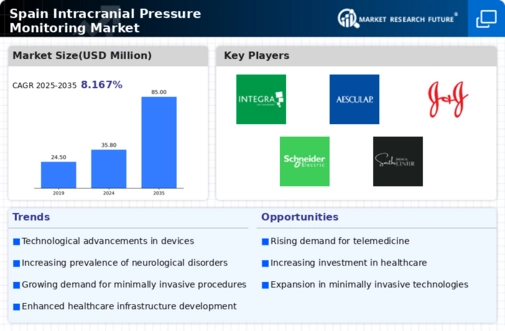The Spain Intracranial Pressure Monitoring Market is evolving with increasing demand for advanced healthcare solutions that emphasize patient safety and effective monitoring of neurological conditions. Key players in this market are leveraging innovative technologies to enhance their offerings, addressing the critical need for accurate diagnostics and treatment solutions in neurocritical care settings. The competitive landscape is marked by ongoing investments in research and development, strategic partnerships, and collaborations aimed at improving existing products and developing next-generation intracranial pressure monitoring systems.
Companies are focusing on expanding their geographical reach within Spain while adapting to regional healthcare regulations, thereby positioning themselves for sustained growth and competitiveness.
Medtronic is a major player in the Spain Intracranial Pressure Monitoring Market, showcasing a robust portfolio of products that cater to the needs of clinicians and patients alike. The company’s strengths lie in its commitment to innovation, with a focus on developing cutting-edge monitoring devices and solutions that improve patient outcomes. Medtronic’s established brand presence is bolstered by its strong distribution networks and an extensive range of services aimed at ensuring device integration and support for healthcare providers.
Its reputation for reliability and technological advancement allows it to maintain a competitive edge in the Spanish market, where healthcare professionals increasingly rely on Medtronic's solutions to facilitate timely and accurate monitoring of intracranial pressure.
Integra LifeSciences has carved out a significant niche in the Spain Intracranial Pressure Monitoring Market through its diverse product offerings and strategic initiatives. The company provides an array of key products, including devices intended for intracranial pressure measurement and support solutions for neurosurgical procedures. Integra LifeSciences emphasizes its strengths in innovative technology and responsive customer service, which resonate well with the Spanish healthcare landscape. The company's presence in Spain is further complemented by various partnerships and collaborations with local healthcare institutions aimed at improving clinical practices.
Recently, Integra LifeSciences has also engaged in select mergers and acquisitions to enhance its capabilities and broaden its product pipeline in response to evolving market demands, which significantly contributes to its competitive position in the region.















